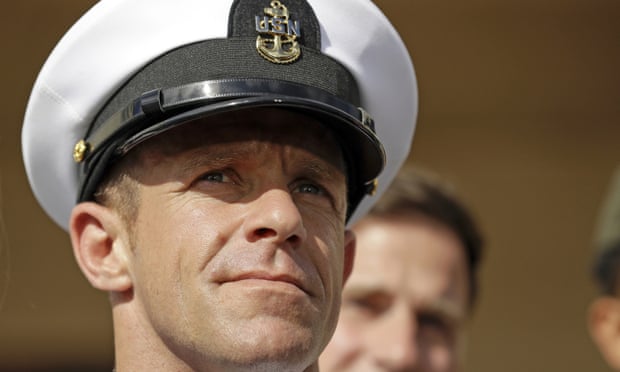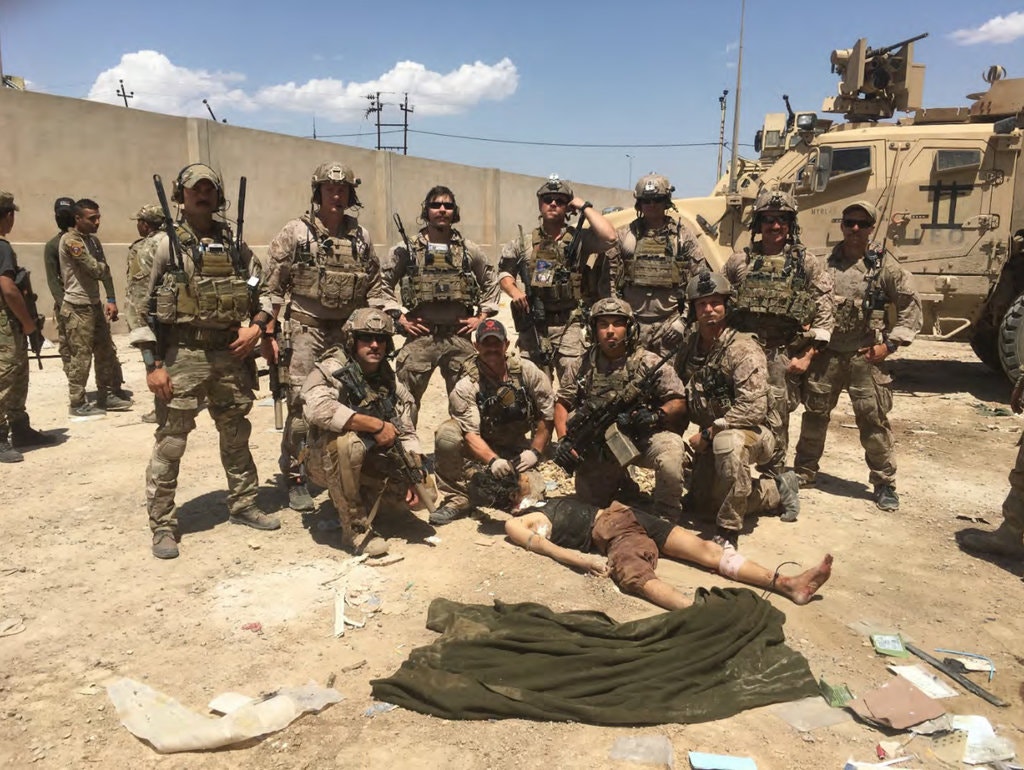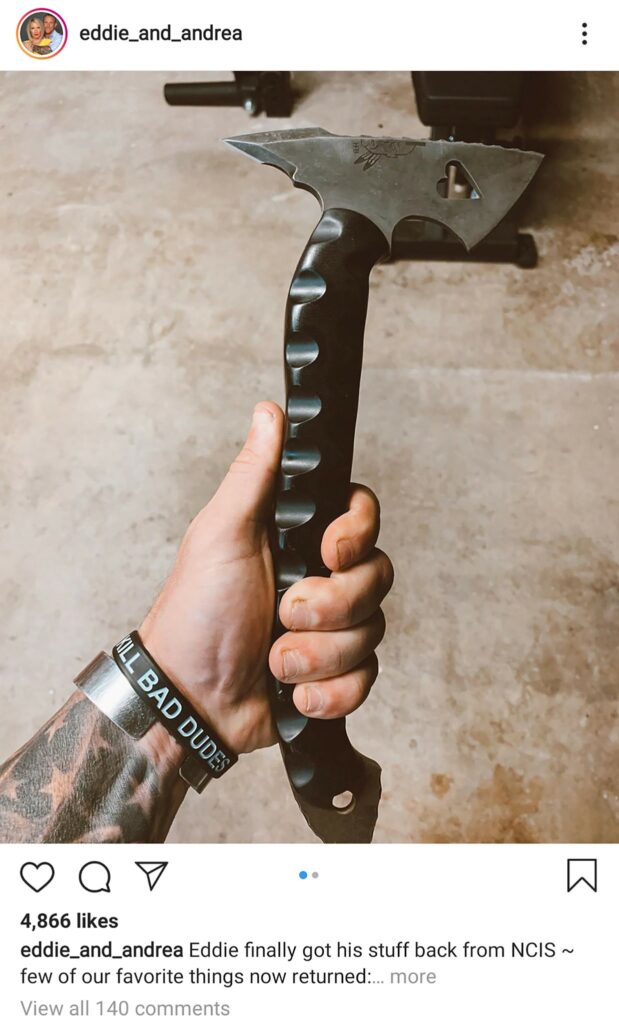Anguish and Anger from the Navy SEALs Who Turned In War Criminal Edward Gallagher
ANGLO AMERICA, 30 Dec 2019
Dave Philipps – The New York Times
Video Interviews and Group Texts Obtained by The Times Show Men Describing Navy Seal Pardoned of War Crimes by Trump as ‘Toxic, Freaking Evil’

Eddie Gallagher was convicted of posing with the dead body of a teenage Isis captive he had just killed with a hunting knife.
Photograph: Gregory Bull/AP
27 Dec 2019 – The Navy SEALs showed up one by one, wearing hoodies and T-shirts instead of uniforms, to tell investigators what they had seen. Visibly nervous, they shifted in their chairs, rubbed their palms and pressed their fists against their foreheads. At times they stopped in midsentence and broke into tears.
“Sorry about this,” Special Operator First Class Craig Miller, one of the most experienced SEALs in the group, said as he looked sideways toward a blank wall, trying to hide that he was weeping. “It’s the first time — I’m really broken up about this.”
Video recordings of the interviews obtained by The New York Times, which have not been shown publicly before, were part of a trove of Navy investigative materials about the prosecution of Special Operations Chief Edward Gallagher on war crimes charges including murder.
They offer the first opportunity outside the courtroom to hear directly from the men of Alpha platoon, SEAL Team 7, whose blistering testimony about their platoon chief was dismissed by President Trump when he upended the military code of justice to protect Chief Gallagher from the punishment.
“The guy is freaking evil,” Special Operator Miller told investigators. “The guy was toxic,” Special Operator First Class Joshua Vriens, a sniper, said in a separate interview. “You could tell he was perfectly O.K. with killing anybody that was moving,” Special Operator First Class Corey Scott, a medic in the platoon, told the investigators.
Such dire descriptions of Chief Gallagher, who had eight combat deployments and sometimes went by the nickname Blade, are in marked contrast to Mr. Trump’s portrayal of him at a recent political rally in Florida as one of “our great fighters.”
Though combat in Iraq barely fazed the SEALs, sitting down to tell Naval Criminal Investigative Service agents about what they had seen their platoon chief do during a 2017 deployment in Iraq was excruciating for them.
Not only did they have to relive wrenching events and describe grisly scenes, they had to break a powerful unwritten code of silence in the SEALs, one of the nation’s most elite commando forces.
The trove of materials also includes thousands of text messages the SEALs sent one another about the events and the prosecution of Chief Gallagher. Together with the dozens of hours of recorded interviews, they provide revealing insights into the men of the platoon, who have never spoken publicly about the case, and the leader they turned in.
Platoon members said they saw Chief Gallagher shoot civilians and fatally stab a wounded captive with a hunting knife. Chief Gallagher was acquitted by a military jury in July of all but a single relatively minor charge, and was cleared of all punishment in November by Mr. Trump.
Video from a SEAL’s helmet camera, included in the trove of materials, shows the barely conscious captive — a teenage Islamic State fighter so thin that his watch slid easily up and down his arm — being brought in to the platoon one day in May 2017. Then the helmet camera is shut off.
In the video interviews with investigators, three SEALs said they saw Chief Gallagher go on to stab the sedated captive for no reason, and then hold an impromptu re-enlistment ceremony over the body, as if it were a trophy.
“I was listening to it, and I was just thinking, like, this is the most disgraceful thing I’ve ever seen in my life,” Special Operator Miller, who has since been promoted to chief, told investigators.
Special Operator Miller said that when the platoon commander, Lt. Jacob Portier, told the SEALs to gather over the corpse for photos, he did not feel he could refuse. The photos, included in the evidence obtained by The Times, show Chief Gallagher, surrounded by other SEALs, clutching the dead captive’s hair; in one photo, he holds a custom-made hunting knife.

This photo, recovered from Chief Gallagher’s phone after the death of an Islamic State fighter, was included in an investigative report by the Navy.
“I think Eddie was proud of it, and that was, like, part of it for him,” Special Operator Miller told investigators.
Chief Gallagher’s lawyer, Timothy Parlatore, said the video interviews were rife with inconsistencies and falsehoods that created “a clear road map to the acquittal.”
Since his arrest nearly a year ago, Chief Gallagher has insisted that the charges against him were concocted by six disgruntled SEALs in his platoon who could not meet his high standards and wanted to force him out.
“My first reaction to seeing the videos was surprise and disgust that they would make up blatant lies about me, but I quickly realized that they were scared that the truth would come out of how cowardly they acted on deployment,” Chief Gallagher said in a statement issued through his lawyer.
“I felt sorry for them that they thought it necessary to smear my name, but they never realized what the consequences of their lies would be. As upset as I was, the videos also gave me confidence because I knew that their lies would never hold up under real questioning and the jury would see through it. Their lies and N.C.I.S.’s refusal to ask hard questions or corroborate their stories strengthened my resolve to go to trial and clear my name.”
The video interviews and private group text conversations obtained by The Times do not reveal any coordinated deception among the SEALs in the chief’s platoon. Instead, they show men who were hesitant to come forward, but who urged one another to resist outside pressure and threats of violence, and to be honest.
“Tell the truth, don’t lie or embellish,” one sniper who is now in SEAL Team 6 told the others in a group text in 2017, when they first tried to report the chief. “That way, he can’t say that we slandered him in any way.”
When several SEALs in the group questioned what would come of reporting the chief to their commanders, another wrote: “That’s their decision. We just need to give them the truth.”
It is an unspoken rule among their teams that SEALs should not report other SEALs for misconduct. An internal investigation could close off choice assignments or end careers for the accusers as well as the accused. And anyone who reported concerns outside the tight-knit SEAL community risked being branded a traitor.
“In a perfect world, there would be no risk, but that is not where we are,” Rick Haas, a retired command master chief who served in the SEALs for 30 years, said in an interview with The Times. “The teams are now divided over this, like I’ve never seen happen before.”
In cramped interview rooms in San Diego, SEALs who spoke to Navy investigators painted a picture of a platoon driven to despair by a chief who seemed to care primarily about racking up kills. They described how their chief targeted women and children and boasted that “burqas were flying.”
Asked whether the chief had a bias against Middle Eastern people, Special Operator Scott replied, “I think he just wants to kill anybody he can.”
Some of the SEALs said they came to believe that the chief was purposefully exposing them to enemy fire to bait ISIS fighters into revealing their positions. They said the chief thought that casualties in the platoon would increase his chances for a Silver Star.
Special Operator Vriens told investigators he had wanted to confront the chief in Iraq but had worried that if he did, he would be cut from missions and no longer be present to protect other SEALs from the chief. As he spoke, he struggled to keep his composure.
“I can speak up, stand my ground,” he said in the interview. “He’s just going to do this to a new guy who he can manipulate. So I was like, I’m going to be his right-hand man, so — so no one else got hurt.”
He pressed his forehead into his fists and started to cry. Then he took several deep breaths, rubbed his hands together and tried to continue.
“So I worked for him and I kept my mouth shut,” he said.
The platoon members told investigators that they tried repeatedly to report what they saw, but that the chain of command above them was friendly toward Chief Gallagher and took no action. Finally, in April 2018, they went outside the SEALs to the Naval Criminal Investigative Service. Chief Gallagher was arrested a few months later.
The SEALs in the platoon were scattered to new assignments. They tried to keep tabs on the case, texting one another and commiserating over a series of setbacks, including accusations of prosecutorial misconduct, the removal of the lead prosecutor and reports that the judge overseeing the case was being investigated on suspicion of lying under oath.
“This stuff is frustrating to read and makes it seem like Eddie will possibly get away with murder (literally),” Special Operator First Class Dylan Dille texted the group. “Let’s not forget there are 7-12 of us in here who had the balls to tell the truth about what Eddie has done.”
He said he thought the case against Chief Gallagher was strong despite the procedural setbacks. “I am also convinced that we are gonna answer to a higher power someday, and everything happens for a reason,” wrote Special Operator Dille, who has since left the Navy. “Not compromising our integrity and keeping right on our side is all we can do.”
Seven members of the 22-person platoon testified at the trial that they saw the chief commit war crimes. Two men from the platoon testified that they did not see any evidence of crimes. Others refused to cooperate with prosecutors, which a lawyer for some of the men said they would not do without being granted immunity. Crucially, one SEAL who had accused the chief during the investigation — Special Operator Scott — changed his story on the witness stand, testifying that he and not Chief Gallagher had caused the captive’s death.
Three of the men who testified at the trial left the Navy afterward, and have been trying to keep a low profile while they build civilian lives. Others are still in the SEAL teams, in some cases working on classified assignments. Some fear that coming forward has hurt their chances at success in the SEALs, but none have reported any retaliation. All of them declined to comment for this article.
Since the trial, Chief Gallagher has repeatedly insulted them on social media and on Fox News, especially Craig Miller, whom the chief singled out for weeping while talking to investigators.
Chief Gallagher retired from the Navy with full honors at the end of November, and has announced that he was starting a SEAL-themed clothing line.

A screenshot from an Instagram account belonging to Officer Gallagher and his wife shows a custom-made hatchet.
A few days after he retired, an Instagram account belonging to him and his wife posted a photo of a custom-made hatchet, forged by the same SEAL veteran who made the hunting knife he was accused of using to kill the captive. Before the deployment, Chief Gallagher had told the knife maker he hoped to “dig that knife or hatchet on someone’s skull!”
“Eddie finally got his stuff back from NCIS,” the post said, listing the hatchet among a “few of our favorite things now returned.”
https://www.instagram.com/p/B6XJ30lpKMq/?utm_source=ig_embed
Another item returned to him was a black-and-white Islamic State flag. On Saturday, Chief Gallagher presented Mr. Trump with a folded black-and-white cloth that other SEALs from the platoon said appeared to be the flag.
A post on the chief’s Instagram account said, “Finally got to thank the President and his amazing wife by giving them a little gift from Eddie’s deployment to Mosul.”
_______________________________________________
A Navy SEAL Investigation:
- Confidential Videos Show Why Navy SEALs Reported Edward Gallagher Dec. 27, 2019
- Navy Wants to Eject From SEALs a Sailor Cleared by Trump, Officials Say Nov. 19, 2019
- Who Is Edward Gallagher, the SEAL the Navy Wants to Expel? Nov. 24, 2019
- Navy SEALs Were Warned Against Reporting Their Chief for War Crimes April 23, 2019
- Navy SEALs Case Reveals Broad Scope of a President’s Military Powers Nov. 22, 2019
Dave Philipps covers veterans and the military, and is a winner of the Pulitzer Prize for National Reporting. Since joining the Times in 2014, he has covered the military community from the ground up.
A version of this article appears in print on Dec. 27, 2019, Section A, Page 1 of the New York edition with the headline: Anguished SEALs Recall Chief as ‘Evil’ and ‘Toxic’.
Tags: Conflict, Cruelty, Justice, Pentagon, Trump, US Military, USA, Violence, War, War crimes
DISCLAIMER: The statements, views and opinions expressed in pieces republished here are solely those of the authors and do not necessarily represent those of TMS. In accordance with title 17 U.S.C. section 107, this material is distributed without profit to those who have expressed a prior interest in receiving the included information for research and educational purposes. TMS has no affiliation whatsoever with the originator of this article nor is TMS endorsed or sponsored by the originator. “GO TO ORIGINAL” links are provided as a convenience to our readers and allow for verification of authenticity. However, as originating pages are often updated by their originating host sites, the versions posted may not match the versions our readers view when clicking the “GO TO ORIGINAL” links. This site contains copyrighted material the use of which has not always been specifically authorized by the copyright owner. We are making such material available in our efforts to advance understanding of environmental, political, human rights, economic, democracy, scientific, and social justice issues, etc. We believe this constitutes a ‘fair use’ of any such copyrighted material as provided for in section 107 of the US Copyright Law. In accordance with Title 17 U.S.C. Section 107, the material on this site is distributed without profit to those who have expressed a prior interest in receiving the included information for research and educational purposes. For more information go to: http://www.law.cornell.edu/uscode/17/107.shtml. If you wish to use copyrighted material from this site for purposes of your own that go beyond ‘fair use’, you must obtain permission from the copyright owner.

